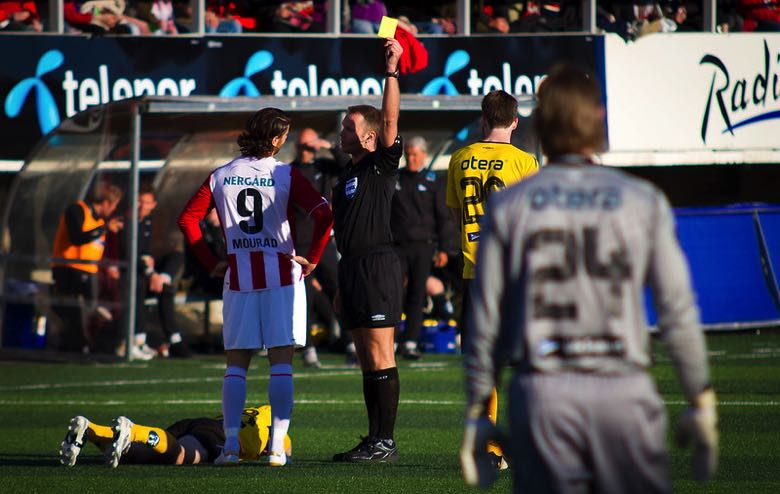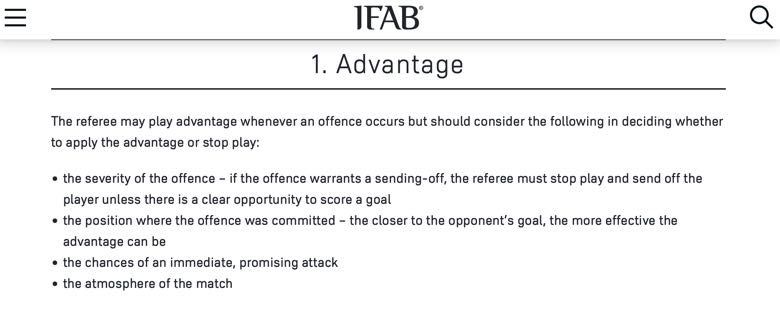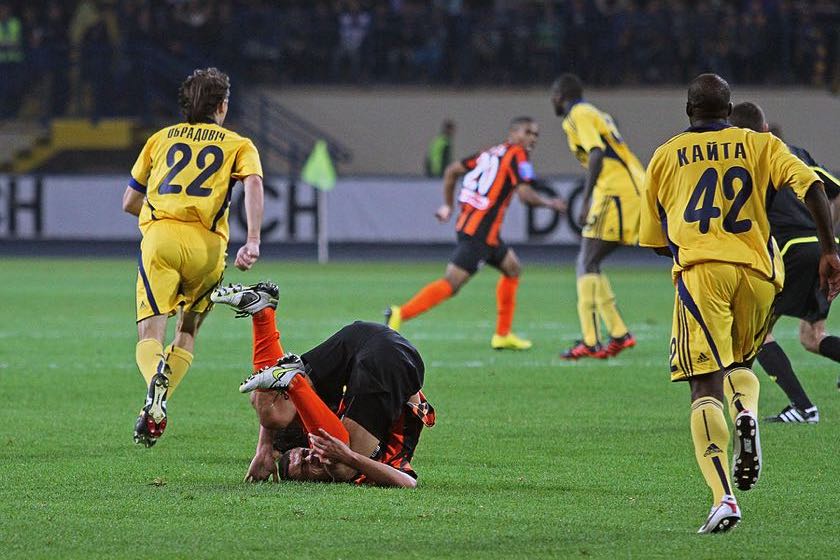Once upon a time, a defender could commit an offence – be it a scything foul on an attacker or a deliberate handball – that prevented a promising forward move and give themselves a pat on the pack, knowing that what they’d done had been beneficial to their team.
But in a bid to minimise the amount of gamesmanship in football, the sport’s law-makers came up with a new initiative – the advantage rule – that would enable referees to allow the play to continue if the attacking side still had a chance to fashion a goalscoring opportunity despite being on the receiving end of an offence. And, so ‘playing advantage’ was born.
What Is the Advantage Rule in Football?
Although an unwritten rule, to some extent, the advantage law allows referees the discretion to not blow their whistle to signal a foul, handball or other misdemeanour if the attacking team remain in an advantageous position anyway.
When the ref is happy to play advantage, you will see them raise their arms to shoulder height in the direction that the attacking team is shooting towards – signalling that there is no stoppage and the players should continue as normal. Although the official has the freedom to decide when to allow play to continue via the advantage rule, they should only do so when three boxes are ticked:
- The attacking team has a clear advantage and would not be better served with a free kick
- When no player on the pitch has suffered a serious injury
- When playing advantage would exacerbate a situation (e.g. if one or more players has lost their temper then stopping the game would perhaps be smarter)
If these three criteria are satisfied, the referee then has to decide very quickly whether the attacking team would rather have the advantage played or a free kick awarded – the latter being more likely if the infringement takes place within shooting range of the opposition’s goal.
These split-second decisions are particularly tough for a referee – see the 2006 Champions League final, when Arsenal goalkeeper, Jens Lehmann, brought down Barcelona forward, Samuel Eto’o. The ball rolled on to Ludovic Giuly, who tapped it into the empty net, but the ref had already blown for the foul, as opposed to playing advantage, so the goal didn’t stand while Lehmann was, as per the letter of the law, sent off.
Then there are other times, like in the Old Firm derby of 2020/21 between Celtic and Rangers, where the referee handles the moment perfectly:
If a team is close to their own goal or lacking any advantage from the infringement whatsoever, the referee will often blow for the free kick instead of allowing play to go on – that minimises the risk of the side in question conceding a goal after the ref had given them a so-called advantage.
Can a Yellow Card Be Shown After Advantage is Played?

One of the key caveats of the advantage rule is that the referee must adhere to the general rules of football when dealing with any offences that occurred immediately prior to him or her playing advantage.
For instance, if a defending player has committed a clear and obvious foul that prevented an opponent progressing towards their goal, or if they handle the ball in a way that prevents the attacking team from launching an attack, then the referee will return to them at the next available stoppage and show them the yellow or red card as appropriate.
Occasionally, the advantage rule won’t be played when a player has committed an act so egregious that they should be instantly sent off. As per football’s official rulebook, these scenarios include:
- Serious foul play
- Violent conduct
- A second cautionable offence
The only exception to this amendment to the advantage rule is where stopping the game would prevent the attacking team from enjoying a clear goalscoring opportunity – in this case, the referee will let play go on until that phase has ended, before showing the red card to the offending player.
How Long Does Advantage Last in Football?
We know that a referee has the discretion to play the advantage rule, but do they have free reign to decide how long the advantage lasts for? The answer is: yes, sort of.
It is generally accepted that the period of advantage will last for a couple of seconds. If the attacking team loses possession in this quick timeframe or gains no advantage, the referee can decide to blow up and award the original free kick if they deem fit too. However, if the attacking team loses the ball after these few seconds are up, there is no requirement for the referee to award them a free kick as the original offence would have allowed for.
This length of advantage really is at the discretion of the match official, although its implied that they won’t often resort to bringing play back to the original offence – if an attacking player is fouled but then gets up and has a shot, for example, it’s considered that the window of advantage is over already, so no free kick will be awarded.
Can the Referee Play Advantage If There’s a Foul in the Box?

This is the ultimate conundrum for a referee. An attacking player is felled in the 18-yard box by a defender. Ordinarily, this situation would result in a penalty and perhaps a red card for the offender – a situation that the attacking team would gratefully receive. But what if the same phase of play continues and there’s a clear and obvious chance that a goalscoring opportunity would develop?
The referee must show the clarity of mind to remember IFAB’s guidance on the advantage rule: they should let play go on if the attacking team still has a clear chance to score – even at the expense of the penalty. As we’ve learned, they can go back and send off the offender if their misdemeanour is serious enough, although the referee cannot award the penalty if the attacking team is given the advantage, plays on and shoots but fails to score.

